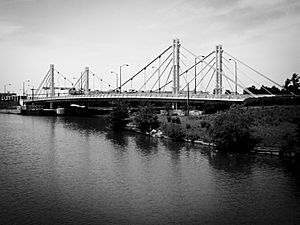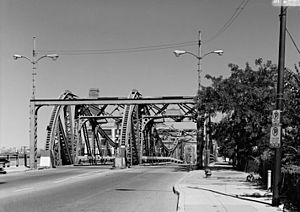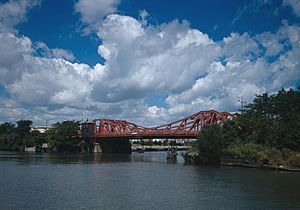North Avenue Bridge facts for kids
Quick facts for kids North Avenue Bridge |
|
|---|---|

North Avenue Bridge from Goose Island
|
|
| Coordinates | 41°54′39″N 87°39′25″W / 41.9108°N 87.6569°W |
| Carries | 4 lanes of North Avenue ( |
| Crosses | North Branch of the Chicago River |
| Locale | Chicago, Illinois |
| Official name | North Avenue Bridge |
| Characteristics | |
| Design | Hybrid suspension/cable-stayed |
| Total length | 420 ft (128 m) |
| Width | 78.5 ft (23.9 m) |
| Height | 50 ft (15 m) |
| Longest span | 252 ft (77 m) |
| Clearance below | 18 ft (5 m) |
| History | |
| Construction begin | Mid-June, 2006 |
| Construction end | May 23, 2008 |
| Opened | May 23, 2008 |
| Statistics | |
| Daily traffic | 40,000 |
The North Avenue Bridge is a special bridge in Chicago, Illinois. It carries North Avenue (also known as Illinois Route 64) over the North Branch of the Chicago River. Over the years, three different bridges have stood in this spot.
The first bridge, built in 1877, was a swing bridge. This type of bridge could swing open in the middle to let boats pass. In 1907, a new bridge called a bascule bridge replaced it. Bascule bridges lift up, giving boats even more room.
By 2006, the bascule bridge was old and couldn't handle all the traffic. So, it was taken down. A brand new, modern bridge was built in its place. This new bridge is a mix of a suspension bridge and a cable-stayed bridge. It fully opened on May 23, 2008.
Contents
Bridge History
As Chicago grew into a big city for business in the late 1800s, many old bridges were replaced. The most common type of new bridge was the center-pier swing bridge. These bridges let people and wagons cross the Chicago River. They could also swing open to let ships pass. One of these swing bridges was built near Goose Island in 1877.
Bascule Bridge Development
The 1877 swing bridge and others like it caused problems for both shipping and land development in Chicago. Ships were getting bigger, and the middle supports of the swing bridges made it hard for them to pass safely. Also, swing bridges needed a lot of open space around them. This stopped new docks and buildings from being built near the river. As land became more valuable, people wanted better bridges.
In 1890, the United States Congress gave the U.S. War Department permission to build new bridges. They could also force changes to old bridges that were dangerous for ships. In 1892, the U.S. Army Corps of Engineers ordered a new bridge to be removed because it was a hazard. After this, Chicago's engineers started looking for better bridge designs.
There was some disagreement about the best type of bridge. The Scherzer Rolling Lift Company suggested their "rolling lift" bridge, which was a type of bascule bridge. However, engineers found that this design could damage weak foundations. So, the city's chief engineer, John E. Ericson, looked at bridges in other countries. He found that the Tower Bridge in London (built in 1894) was a good model to start from.
Ericson's design was free to use and had a simple way of moving. In 1900, he convinced the Chicago City Council to set aside money to replace five old swing bridges. The first of these new bridges were built between 1902 and 1904. At the same time, the Scherzer Company built seven of their rolling lift bridges over the Chicago Sanitary and Ship Canal. These bridges were approved by the Corps of Engineers, not the city's Public Works department.
By 1904, the city had permission to borrow money to replace the rest of the swing bridges. Ericson asked both the Scherzer Company and the Sanitary District for their bridge designs in 1905. A design by John W. Page was rejected. The Scherzer Company also submitted two designs, but they were also rejected. The city then chose Ericson's "trunnion style" bascule bridge. Two companies won contracts to build it: Jackson and Corbett Company for the base, and Roemheld and Gallery Company for the top part.
Scherzer took the city to court, saying their design was better and cheaper. But they reached an agreement in August 1905. Construction for the new North Avenue Bridge began in early 1906. Ericson was later moved from the bridge division. However, the city continued to prefer the trunnion bascule design for its bridges.
The 1907 Bridge
The 1907 bridge was about 260 feet (79 m) long. It looked like a Pratt truss bridge, which is a common design. But unlike most Pratt trusses, the ends of the North Avenue Bridge curved upwards. Strong supports were added where the ends were tallest.
The bridge deck was 60 feet (18 m) wide at the ends. The road was made of wood blocks on a concrete base. The sidewalks were concrete with steel railings. On the parts that lifted, the wooden road was 42-foot (13 m) wide. It had two 9-foot (3 m) metal brackets for plank sidewalks. The road was split by a center support. Originally, streetcar tracks ran on both sides of the bridge.
Shipping Decline and Bridge Replacement
After new factories opened on the Calumet River in southern Chicago, fewer ships used the Chicago River. By the mid-1920s, the city wanted to replace the moving bridges with fixed ones. This was because they cost a lot to maintain. The Army Corps of Engineers didn't agree at first. But except for a short increase during World War II, shipping traffic stayed low.
The old bridge was last lifted in 1972. By the 1990s, the Corps of Engineers agreed to let Chicago change its lift bridges to fixed ones. The area around the bridge changed from factories to homes and shops. More cars used the old bridge, causing traffic jams.
Because of a law called the National Historic Preservation Act of 1966, the city offered the old bridge to anyone who wanted to move and save it. But no cities wanted it because its lifting parts were too old and complex.
New Bridge (2007-2008)
Because the old bridge was so old and expensive to keep up, a new fixed bridge was built from 2007 to 2008. The new bridge is a mix of a suspension bridge and a cable-stayed bridge. It's the same height as the old one but almost twice as long. The old bridge had two lanes, but the new one has four lanes plus sidewalks. This helps with the 40,000 cars that cross the bridge every day.
James McHugh Construction Company built the new bridge. The design for the new North Avenue Bridge had some challenges. A train track runs along the east side of the river, so the bridge had to go over it. The river banks also needed to stay open for future building. The United States Coast Guard said the bridge had to be at least 18 feet (5 m) above the water. Also, the new bridge is at the top of Goose Island and has a clear view of the Chicago skyline, so it needed to look nice.
Building another bascule bridge was too expensive because steel costs were rising. The crossing was too short for a pure suspension bridge. A pure cable-stayed bridge would need a very tall tower, which wasn't preferred. So, engineers decided on a hybrid design that combined both types.
Before building the new bridge, workers built a temporary bridge just north of the site. This temporary bridge allowed them to move utility lines, build a stronger river wall, and work on the new bridge's foundation without stopping traffic. The middle part of the new bridge was built on three barges in the Chicago River. This was important because the Coast Guard required the river channel to stay open. Once the middle part was ready, it was floated to the bridge site. Then, 16 jacks lifted it into place.
The new bridge was finished in 22 months and cost US$25,000,000. The bridge is held up by four pairs of tall supports called pylons. Each pylon weighs 95,000 pounds (43,091 kg). These pylons sit on 10 smaller "micropiles" that go 90 feet (27 m) deep into the bedrock. From the pylons, 24 cables support the parts of the bridge leading up to the main span. A main suspension cable runs from the ends of the bridge to the tops of the pylons, supporting the very middle of the bridge.
The bridge deck is made of 10 inches (25 cm) of strong concrete with a 2-inch (5 cm) latex layer on top. This makes the deck very strong and helps transfer the bridge's forces to anchor blocks at the ends. The total thickness of the deck is only 4 feet (1 m).
Gallery






